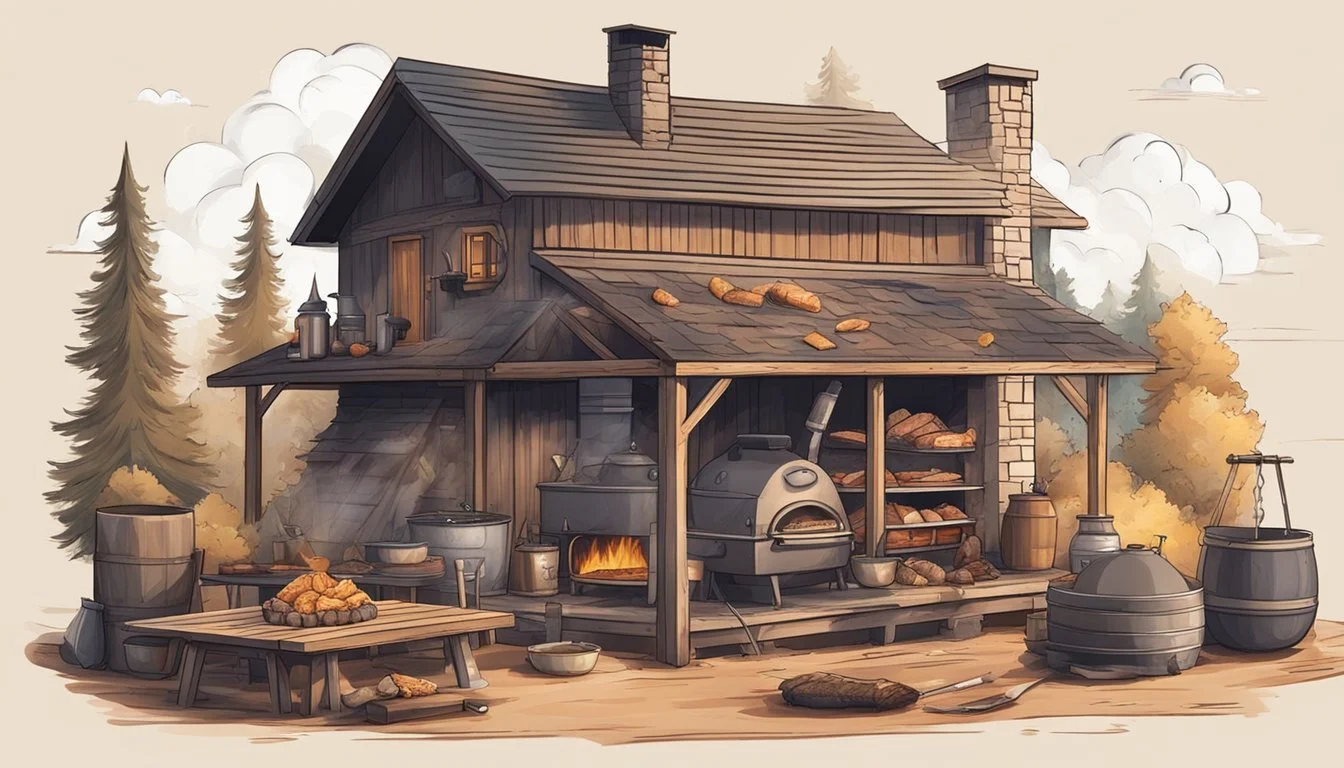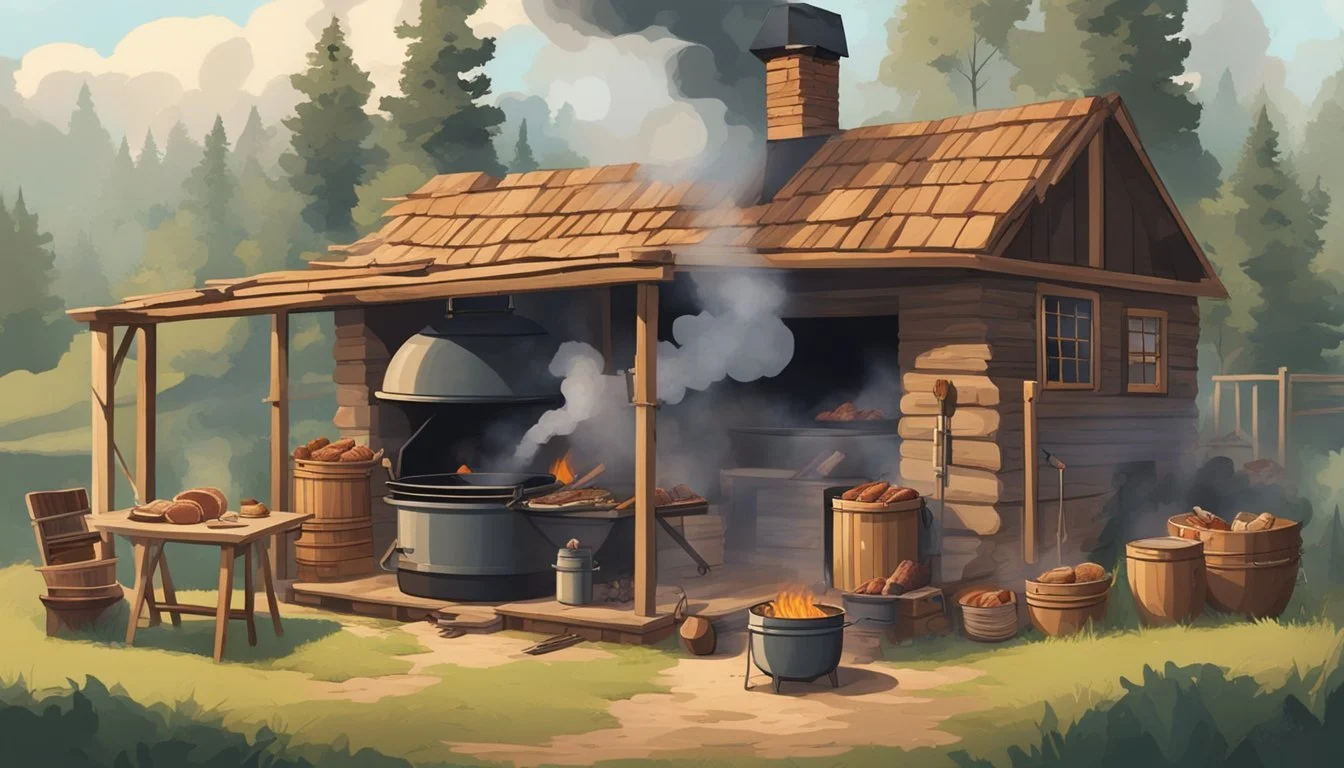Master the Art of Smoking Meat and Fish
Guide to the Best Smoker for Homesteaders
The art of smoking meat and fish is an ancient technique that homesteaders can adopt to enhance flavors and preserve food. This method, often considered both a science and an art, involves cooking food slowly over low heat with the application of wood smoke. It imparts a unique taste that cannot be replicated by any other cooking method. Mastering this technique requires understanding the subtleties of temperature control, choosing the right wood, and maintaining the perfect smoke balance.
Choosing the right smoker is pivotal for any homesteader wanting to excel in this culinary art. A versatile and user-friendly smoker serves as the cornerstone for consistently producing succulent, perfectly smoked meats and fish. The ideal smoker offers ease of temperature management, adequate space for different types of food, and durability to withstand various environmental conditions.
By mastering the use of a smoker, homesteaders elevate their self-sufficiency, creating a wide array of smoked delicacies from home-raised livestock and freshly caught fish. The smoker becomes not just a tool, but a companion in the quest to achieve the quintessential smoke ring and the most tender, flavor-infused cuts. This skill is a testament to their commitment to quality and tradition in home cooking.
Understanding the Basics of Smoking
Smoking meat and fish is a revered cooking method that combines the use of controlled smoke and low temperatures to impart rich flavor and tenderize proteins. It's a practice that homesteaders and culinary enthusiasts alike can master with an understanding of the key components: smoker types, fuel selections, and fundamental techniques.
Types of Smokers
The market offers a variety of smokers, each with its own advantages. Traditional charcoal smokers provide a classic smoking experience with rich flavor, but they require more hands-on attention for temperature management. Electric smokers are known for their convenience and precise temperature control, making them a user-friendly option for beginners. For those who prefer a hands-off approach, a Masterbuilt electric smoker might be the right choice, as it allows for steady temperature and smoke with minimal intervention.
Charcoal Smokers: Vital for the authentic smoke flavor.
Electric Smokers: Ideal for ease of use and consistent temperature.
Selecting the Right Fuel
The fuel, often in the form of wood or charcoal, is crucial for both heat generation and flavoring the meat with smoke. It's important to choose high-quality, natural resources to avoid unwanted chemicals. Hardwoods like hickory or oak impart a strong, classic smoke flavor suited for beef and pork, while fruitwoods like apple or cherry offer a milder, sweeter note perfect for poultry or fish.
Hardwood: Strong, robust flavor for red meats.
Fruitwood: Mild, sweet flavor ideal for poultry and fish.
Fundamental Smoking Techniques
The smoking process is typically a "low and slow" method, ensuring consistent, low temperatures typically between 225°F and 275°F. The primary goal is to maintain stable temperature and smoke levels throughout cooking, which could last several hours depending on the meat's thickness and type. Smoke flavor is introduced by adding wood chips or chunks to the heat source, carefully balancing smoke output with airflow to avoid bitter, over-smoked meat.
Optimal Smoking Temperature: 225°F - 275°F.
Wood chips/chunks for flavor balance: Ensuring not to oversmoke.
Understanding these core principles is the first step in mastering the art of smoking meat and fish. With the right smoker, fuel, and technique, anyone can achieve flavorful, tender smoked dishes that showcase the depth and tradition of this time-honored cooking craft.
Essential Tools for Smoking
Smoking meat and fish requires precision and the right set of tools. Homesteaders looking to produce perfectly smoked flavors need to invest in key pieces of equipment dedicated to measuring and controlling heat, as well as various accessories that assist in the smoking process.
Measuring and Controlling Heat
Thermometers are an essential aspect of smoking, as maintaining the correct internal temperature is crucial for food safety and quality. A high-quality meat thermometer allows the pitmaster to monitor the meat’s internal temperature, ensuring it reaches the desired doneness without overheating.
Digital Meat Thermometer: Provides accurate readings and often includes multiple probes for checking different sections of meat.
Oven-Grade Thermometer: Measures the smoker's ambient temperature to help maintain a consistent cooking environment.
The addition of water pans can help regulate temperature, adding humidity to the smoker which can prevent the meat from drying out.
Accessories and Aids
To enhance the smoking experience, several accessories should be considered essential:
Smoker Box: A container for wood chips or pellets; it infuses smoke flavor into the meat and fish.
Racks and Grates: Essential for holding meat in place, allowing for even smoke distribution and better air circulation.
Tools such as tongs and spatulas are helpful for handling and moving meat within the smoker, while brushes can be used for applying sauces and cleaning grates post-use. For low and slow cooking, accessories are not just add-ons; they are integral components that contribute to the mastery of the art of smoking.
Preparing Meats and Fish for Smoking
Successful smoking starts with proper preparation, which enhances both flavor and texture. They will explore how to select the best cuts and the importance of brining and marinating for optimal results.
Selecting the Best Cuts
Selecting the right cut is crucial for smoking. For pork, options like shoulders and ribs are favored for their fat content, which keeps them moist during long smoking periods. With beef, cuts such as brisket or short ribs are recommended due to their marbling and thickness. For poultry, whole chickens or turkeys are often chosen, but parts like thighs and drumsticks can also be smoked effectively. When it comes to game and seafood, one should opt for fattier fish such as salmon or trout and game meats that are known for their natural robust flavors.
Meat Type: Pork, Suggested Cuts: Shoulders, Ribs
Meat Type: Beef, Suggested Cuts: Brisket, Short Ribs
Meat Type: Poultry, Suggested Cuts: Whole birds, Thighs
Meat Type: Game, Suggested Cuts: Depends on local availability
Meat Type: Seafood, Suggested Cuts: Salmon, Trout
Brining and Marinating
Brining and marinating are key steps to infuse meat and fish with additional flavor and moisture. A brine typically consists of water, salt, and sugar, and can include aromatic seasoning such as garlic, cloves, and bay leaves. This salty solution should fully cover the meat or fish and is best done for several hours or overnight.
Marinades contain an acidic component like vinegar or citrus juice, combined with oils and a mixture of herbs and spices. A good marinade not only adds flavor but also tenderizes cuts of meat. For more intense flavors, one can apply dry rubs made of a blend of seasonings directly onto the muscle fibers of meats.
Brine Components:
Water
Salt
Sugar
Additional aromatics (optional)
Marinade Must-Haves:
Acid (vinegar or citrus)
Oil
Herbs and spices
It's important not to rush the pre-smoking preparation as the interaction between marinades, brines, and the meat or fish contributes significantly to the final taste and texture.
The Smoking Process
Successful meat and fish smoking requires meticulous control of smoke, heat, and time, along with a mastery of flavor profiles. This blend of precision and artistry transforms simple cuts into tender, aromatic delicacies.
Regulating Smoke and Temperature
Controlling heat and smoke is paramount. The preferred temperature range for smoking meats lies between 225 and 275 degrees Fahrenheit. Homesteaders must manage the airflow to control the intensity of the fire and the amount of smoke enveloping the meat. Hardwoods like hickory, oak, and mesquite are ideal for generating a consistent and controlled smoke, with fruitwoods such as apple and pecan imparting a sweeter flavor.
Ideal woods for smoke flavor:
Hickory: Robust, classic smoke flavor.
Mesquite: Intense, suitable for short smokes.
Oak: Medium-strong, versatile for various meats.
Apple: Mild, sweet, good for poultry and pork.
Pecan: Subtle, nutty, enhances beef and pork.
To achieve desired tenderness, maintain a stable temperature, using vents to regulate the smoker's internal climate. Consistent temperature and smoke density are crucial to the success of the process.
Timing and Patience
The axiom "low and slow" defines the timing aspect of smoking. Larger cuts, such as brisket or pork shoulder, might require several hours—sometimes upwards of 12 or more—to reach the desired internal temperature, making patience non-negotiable. It is not merely about endurance but about allowing the process to gradually break down the connective tissues, rendering the meat exquisitely tender.
Smoking times by meat type:
Pork shoulder: 8-14 hours depending on size
Brisket: 10-12 hours for full brisket
Whole chicken: 3-5 hours
Fish fillets: 1-3 hours, depending on thickness
The internal temperature is a precise indicator of doneness; for most meats, this is in the range of 195 to 205 degrees Fahrenheit. Allowing the meat to rest after smoking further ensures juices redistribute for optimal moisture and flavor.
Creating Flavor Profiles
The intricate dance of flavors in smoking comes from the choice of wood, spices, and herbs. Each wood type offers a unique base aroma: apple and maple produce milder smoke, ideal for delicate flavors like chicken and fish, while hickory and oak contribute a stronger profile suited to red meats.
Enhancing flavors:
Use wood chunks or chips soaked in water for slower burning.
Incorporate herbs and spices in the rubs to complement the natural smoke flavor.
Experiment with combining different woods for complex flavor profiles.
Remember, the goal is a balance—a harmony of smoke and seasoning without overpowering the natural taste of the meat or fish. Each component, from wood selection to spice blend, works in concert to craft an unforgettable smoking experience.
Advanced Smoking Techniques
The homesteader's journey into smoking meat and fish reaches a pinnacle with advanced smoking techniques that elevate the flavor, texture, and overall quality of the food. These methods require thoughtful experimentation, a deep understanding of temperature variations, and the application of both hot and cold smoking processes.
Experimenting with Recipes
To captivate the palate, one must be willing to explore a wide range of recipes. Different cuts of meat and types of fish respond uniquely to various marinades and sauces, creating a symphony of flavors underpinned by smokiness. It's imperative to note the weight, cut, and desired internal temperature for precision cooking, as these factors directly impact flavor and texture.
Example Recipe Framework:
Select cut of meat or type of fish
Define target internal temperature
Choose marinade/sauce
Determine appropriate wood type and smoking time
Hot Smoking vs. Cold Smoking
Hot smoking operates within a temperature range of 200°F to 300°F and is ideal for cooking and flavoring meat simultaneously. It imbues meat with a tender texture while achieving a safe internal temperature. Conversely, cold smoking is a technique at temperatures below 90°F, mostly used for flavoring purposes as it doesn't cook the food. Poultry and sausage are typically hot smoked, while cheese and salmon are often cold smoked for their distinctive flavor profile.
Temperature Guide:
Hot Smoking: 200°F - 300°F
Cold Smoking: Below 90°F
Foods for Hot Smoking: Poultry, Sausage
Foods for Cold Smoking: Cheese, Salmon
Mastering Temperature Transitions
Skilled homesteaders know that managing temperature transitions and maintaining consistent heat is essential for texture and flavor development. This involves adjusting vents for airflow control and using reliable thermometers to ensure accurate readings. Sudden temperature spikes or drops can affect cooking times and potentially lead to under or overcooked meats. Thus, maintaining steady temperatures according to one's chosen cooking method and recipes is crucial for optimal results.
Key Strategies:
Regularly monitor and adjust vents for airflow control
Use a reliable thermometer to track internal temperature
Be patient and allow for slow temperature transitions
Post-Smoking Tips and Tricks
After meticulously managing the smoking process, the attention to detail shouldn't wane once the meat or fish leaves the smoker. Proper post-smoking practices are crucial to enhance flavors and ensure the ideal texture.
Resting the Meat
Before slicing, it's imperative to rest the meat. This allows the juices to redistribute, ensuring each bite is succulent. The resting period varies by the size of the meat but generally ranges from 10 to 30 minutes. Large cuts should ideally rest until they reach an internal temperature of 135°F to 145°F. During this time, the residual heat continues the cooking process to perfection.
Resting Duration:
Small cuts (e.g., sausages, fish filets): 5-10 minutes
Medium cuts (e.g., chicken breasts, pork chops): 10-20 minutes
Large cuts (e.g., briskets, whole turkeys): 20-30 minutes
Serving and Presentation
When it's time to serve, presentation plays a supporting role to taste. Clean cuts of meat or fish, paired with appropriate garnishes, elevate the dining experience. Slice meat against the grain to improve tenderness and serve it with a sauce that complements the smokiness. Drizzle or serve sauce on the side to not overpower the meat's inherent flavors. Maintain the dish's moisture by incorporating a light dab of seasoned butter or glaze to seal in flavors.
Slicing Tip: Always use a sharp knife for precise cuts.
Serving Suggestions:
Serve on warm plates to keep the meat temperature just right.
Accompany with side dishes that contrast and balance the smoky taste, such as crisp salads or creamy coleslaws.
Maintaining Your Smoker
Proper maintenance of a smoker is crucial for both its longevity and the quality of the food it produces. This section addresses two key aspects: meticulous cleaning and storage, as well as troubleshooting common issues that may arise.
Cleaning and Storage
Cleaning the smoker is the first step in maintenance. After each use, one should remove ash, food debris, and grease. Below is a simple checklist:
Grates: Remove and scrub with a grill brush; wash with soapy water, rinse, and dry.
Interior: Wipe surfaces with a damp cloth; avoid using harsh chemicals.
Ash and Grease Trays: Empty and clean to prevent residue buildup.
For storage:
Ensure the smoker is cool and clean.
Cover with a smoker cover to protect from dust and weather.
Store in a cool, dry place to prevent rust and wear.
Troubleshooting Common Issues
Temperature Fluctuations:
Cause: Often due to airflow problems or fuel supply.
Solution: Check vents, fans, or pellet feeds for blockages and clean accordingly.
Smoke Leakage:
Cause: Can be due to worn gaskets or misaligned doors.
Solution: Replace seals and ensure doors are properly fitted.
Inefficient Smoking:
Cause: Frequently a result of improper wood chip quality or quantity.
Solution: Use recommended woods and measure according to the manufacturer’s instructions.
Regular maintenance and timely troubleshooting are essential to keep a smoker in prime condition and ensure it consistently produces high-quality smoked meats and fish.
Beyond the Smoker
When homesteaders master smoking meat and fish, they unlock a world of flavor. However, the journey does not end there; exploring complementary grilling techniques further enhances their barbecue repertoire.
Complementary Grilling Techniques
Direct Grilling and Indirect Grilling are two techniques that, when used in conjunction with smoking, can produce a superior BBQ experience. Direct grilling involves cooking food directly over the heat source, which is perfect for items that cook quickly like steaks and vegetables. It provides a charred, crisp exterior while preserving a juicy interior.
Direct Grilling:
Heat Source: Directly beneath food
Cook Time: Short
Best For: Steaks, kebabs, vegetables
Indirect Grilling is ideal for larger cuts of meat that require longer, slower cooking times at lower temperatures, much like smoking, but without the smoky flavor.
Indirect Grilling:
Heat Source: Off to the side, not beneath food
Cook Time: Longer
Best For: Whole chickens, roasts, large fish fillets
Employing these techniques allows for versatility—sear a smoked brisket over direct heat for a crispy bark, or finish a side of salmon with indirect heat after a light smoking session. They are valuable skills that can elevate one's barbecuing and grilling game beyond the smoker.
The Cultural Significance of Smoking
Smoking meat and fish transcends a simple cooking technique; it embodies a rich cultural tapestry steeped in history and culinary innovation. The method not only imparts a unique flavor but also demonstrates a powerful connection to the past where skill and craftsmanship turned humble ingredients into culinary masterpieces.
Historical Perspectives
Historically, smoking served as an essential food preservation method. Before the advent of refrigeration, people discovered that exposing meats and fish to smoke extended their shelf life. The act of smoking dates back to ancient civilizations and has evolved through the ages. The Scandinavians, for example, developed a swift and practical technique to smoke fish, a testament to smoking's adaptability and cultural integration. Smoking has been culturally significant, enabling societies to survive harsh winters and improving food security.
Key Historical Points:
Ancient Practice: Originated before written records.
Preservation: Essential for survival, especially in colder climates.
Evolution: Techniques refined over centuries.
Smoking in Culinary Arts
In the realm of culinary arts, smoking is a skill that transforms the simplest cuts of meat and the freshest catch into barbeque masterpieces with a depth of flavor that is unmatched by other cooking methods. The act of smoking meat is both a science and an art; it requires precise temperature control, ranging from 225-275 degrees Fahrenheit for ribs to 275-325 degrees Fahrenheit for chicken, to achieve the desired tenderness and taste. Chefs and home cooks alike experiment with a variety of dry rubs and marinades, infusing meats with complex flavor profiles that are eagerly savored and celebrated in BBQ cultures around the world.
Skill and Craftsmanship:
Precise Temperature Control
Brisket: 225-250°F
Ribs: 225-275°F
Chicken: 275-325°F
Dry Rubs and Marinades: Enhance flavor profiles.
BBQ Celebrations: Showcase culinary mastery.
Becoming a Pitmaster
A pitmaster is one who has honed their skills in the craft of smoking meat and fish, utilizing knowledge and patience to create unique flavors. They are confident in their approach and possess a deep understanding of the processes that impart distinct tastes and textures to food. The journey to becoming a pitmaster involves developing a specific set of skills, backed by a clear and neutral mindset towards learning and perfecting the art.
Essential Skills:
Temperature Control: Mastery over heat management ensures even smoking and prevents overcooking.
Wood Selection: Knowing which type of wood complements different meats contributes to the unique flavor profiles.
Timing: Understanding how long to smoke various cuts and species of protein is fundamental.
Key Knowledge Areas:
Types of smokers and their uses
Meat preparation techniques
Recognizing ideal smoking conditions
Patience: A crucial trait of any pitmaster, as smoking is a low and slow process.
Tips and Tricks:
Develop a consistent preparation routine for meats, including trimming and seasoning.
Keep a detailed log of smoking times, temperatures, and outcomes for reference.
Experiment with different wood and meat combinations to discover new flavors.
By meticulously applying these skills, tips, and tricks, the aspirant refines their techniques and steadily progresses toward pitmaster status. It is through a dedication to the craft that they can ultimately master the art of imparting that sought-after smoky taste.







